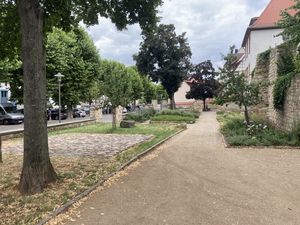After the Heppenheim moat was filled in after 1849, a park-like area developed in front of the southern city wall and the former official winery. Monuments reminiscent of military conflicts and their consequences were erected here. In the section of the moat to the west of the city wall, a garden separated by an enclosing wall was created with the expansion of the district office from 1904/07. After the district of Bergstraße had allowed the city of Heppenheim to use it, the walls were dismantled and the "district office garden" was renamed "Marianne-Cope-Garten" in 2017 in memory of St. Sister Maria Anna Koob, who was born in Heppenheim in 1838. Marianne Cope, who emigrated to America, joined the Third Order of Franciscan Sisters at the age of 24, was appointed Superior in 1875 and two years later elected Superior General. She devoted 30 years of her life to caring for lepers on a nearly inaccessible peninsula of Moloka'i. She not only took care of the physical suffering of the lepers, but also wanted to give the forgotten their dignity back.
The memorial complex and the Marianne Cope Garden form a common park with monuments from different historical eras. Also on display is a pavement found in Heppenheim in 1955 from a Roman road running along the Bergstrasse.
The following monuments are signposted didactically:
- City Wall and Biberhof Tower
- Pavements of the Roman road running along the Bergstrasse
- Collection of historical stones with border stone of the castle estate and "post stone"
- Baroque portal of the "Zur Sonne" inn with a statue of the Virgin Mary
- Four memorial stones and a commemorative plaque for the battle of May 30, 1849 near Heppenheim
- Memorial stone ("Snake Stone") for the burgrave of Starkenburg, Ulrich von Kronberg, who fell in 1460
- Nike, the Greek goddess of victory, in memory of the Franco-Prussian War of 1870/71
- Memorial wall from 1936 with the names of the Heppenheimers who died in World War I and the figure of a mourner placed in front of it in 1963 to commemorate the Heppenheim victims of World War II
- memorials ("Russenstein, "Give them free", memorial to displaced persons) to the consequences of the Second World War
Monuments 5-9 are memorials that serve to commemorate and memorize the dead and consequences of these wars and demonstrate the importance of peace and enmity overcome.

